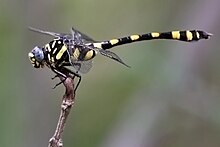Ictinogomphus
| Ictinogomphus | |
|---|---|

| |
| Ictinogomphus rapax (Common Clubtail) | |
| Scientific classification | |
| Kingdom: | Animalia |
| Phylum: | Arthropoda |
| Class: | Insecta |
| Order: | Odonata |
| Infraorder: | Anisoptera |
| Family: | Lindeniidae |
| Genus: | Ictinogomphus Cowley, 1934[1] |

Ictinogomphus is a genus of dragonflies in either the family Gomphidae or Lindeniidae.[2][3] They are medium to large, yellow and black with clear wings.[4] Species occur in Africa, Asia and Australia.[4]
Genera[]
The genus Ictinogomphus includes the following species:[2]
- Yousuf & Yunus, 1976
- (Selys, 1854)
- Ictinogomphus australis (Selys, 1873) - Australian Tiger[4]
- (Schmidt, 1934)
- (Selys, 1854) - Common flangetail
- Ictinogomphus dobsoni Watson, 1969 - Pilbara Tiger[4]
- (Pinhey, 1961) - Swamp Tigertail[5]
- Ictinogomphus ferox (Rambur, 1842) - Common Tiger, Common Tigertail[6]
- Kimmins, 1958
- Ram, 1985
- Ictinogomphus paulini Watson, 1991 - Cape York Tiger[4]
- (Hagen in Selys, 1854)
- Yousuf & Yunus, 1976
- Ictinogomphus rapax (Rambur, 1842) - Common Clubtail[7]
- Ictinogomphus regisalberti (Schouteden, 1934)
- (Hagen in Selys, 1854)
Notes on taxonomy[]
Jules Rambur originally described this genus as Ictinus in 1842.[8] However, at the time there already existed a genus of beetle also named Ictinus described by François Laporte in 1834.[9] In 1934, John Cowley, an English entomologist, renamed this species to Ictinogomphus in deference to Rambur's original name. Cowley is now regarded as the authority, and this genus can be formally written as: Ictinogomphus Cowley, 1934.[3]
The Australian Faunal Directory considers the genus Ictinogomphus to belong to the family Lindeniidae.[3] The World Odonata List at Slater Museum of Natural History, University of Puget Sound considers the genus Ictinogomphus to belong to the family Gomphidae.[2]
References[]
- ^ Cowley, J. (1934). "The types of some genera of Gomphidae (Odonata)". The Entomologist. 67: 273–276 [274].
- ^ Jump up to: a b c Martin Schorr; Dennis Paulson. "World Odonata List". University of Puget Sound. Retrieved 12 October 2018.
- ^ Jump up to: a b c "Genus Ictinogomphus Cowley, 1934". Australian Faunal Directory. Australian Biological Resources Study. 2012. Retrieved 22 March 2017.
- ^ Jump up to: a b c d e Günther Theischinger; John Hawking (2006). The Complete Field Guide to Dragonflies of Australia. CSIRO Publishing. ISBN 0-643-09073-8.
- ^ Clausnitzer, V.; Suhling, F. & Kipping, J. (2010). "Ictinogomphus dundoensis". IUCN Red List of Threatened Species. 2010: e.T63190A12615558. doi:10.2305/IUCN.UK.2010-3.RLTS.T63190A12615558.en.
- ^ Clausnitzer, V.; Suhling, F. & Dijkstra, K.-D.B. (2009). "Ictinogomphus ferox". IUCN Red List of Threatened Species. 2009. Retrieved 8 November 2010.
- ^ Subramanian, K. A. (2005). Dragonflies and Damselflies of Peninsular India (PDF).
- ^ Rambur, Jules (1842). Histoire naturelle des insectes. Névroptères (in French). Paris: Librairie Encyclopédique de Roret. pp. 534 [171] – via Gallica.
- ^ Laporte, F. (1834). Audouin, J.V.; Brullé, G.A. (eds.). Histoire naturelle des insectes, traitant de leur organisation et de leurs moeurs en général, par M. V. Audouin et comprenant leur classification et la description des espèces, par M. A. Brullé. Paris: F.D. Pillot. pp. 479 [259]. doi:10.5962/bhl.title.34228 – via Biodiversity Heritage Library.
External links[]
![]() Media related to Ictinogomphus at Wikimedia Commons
Media related to Ictinogomphus at Wikimedia Commons
![]() Data related to Ictinogomphus at Wikispecies
Data related to Ictinogomphus at Wikispecies
- Lindeniidae
- Gomphidae
- Anisoptera genera
- Odonata of Asia
- Odonata of Africa
- Odonata of Australia
- Taxa named by John Cowley (entomologist)
- Insects described in 1934